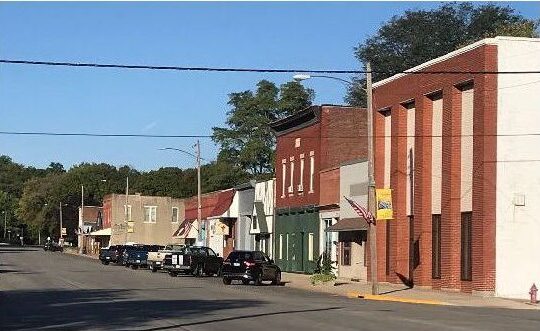About Us
The History of Tiskilwa
Tiskilwa is a village where “The Past Is Present” – not only in the warm, old- fashioned welcome that visitors receive but also in the 19th century buildings that still line Main Street and the stately homes that stand in pride of place throughout the town.
Tradition has established four blocks of Main Street with stores, restaurants, and offices on the north side, while historic churches and residences grace the south side. The business district is flanked by two inviting parks, East and West, with picnic shelters, play equipment, war memorials, and a gazebo.
Tiskilwa has a proud and storied history, one with many ebbs and flows. The photos above show the same view of Main Street, looking west, in the early and mid-twentieth centuries. At this point in the 21st century, there seems to be a modest renaissance afoot with new businesses catering to tourism in this scenic area of Illinois, situated with the Hennepin Canal State Park running along the north and east edges of town. Below, we have views of today’s Main Street and the canal.
Nestled in a valley surrounded by wooded bluffs, the village of Tiskilwa was once home to the Potawatomi, in whose poetic language its name means “Gem of the Valley.” A half-dozen roads lead out of town, but only one can be followed that does not climb a hill. Country roads winding through rolling hills in the midst of our so-called Prairie State often surprise and please Tiskilwa’s visitors.
From these hills flow the many springs that feed Rocky Run (called Wapsipinicon by the Potawatomi) as it meanders eastward through the village and into Big Bureau Creek. Officially established on paper in the 1830s, Tiskilwa has been known by many names, including Wappe, Indiantown, Windsor and West Windsor. When the Chicago, Rock Island and Pacific Railroad was completed in 1853 (the first railroad in Bureau County), the name of Tiskilwa was proposed as a compromise and settled upon at a town meeting.
Although numerous artifacts preserved in Tiskilwa’s Museum on Main have been identified by professionals as thousands of years old, the first record of settlement in this valley is 1769, when a band of Potawatomi traveled west from the Wabash Valley. It is estimated that by the early 1800s, there were 1,500 to 2,000 Native American inhabitants here, and that Bureau County was the most densely populated area in the territory that would be designated as Illinois in 1818. The residents lived in 300-400 lodges (or wigwams) made of bark with an opening in the center of the ceiling to let smoke escape. Their life here was supported by growing corn as well as berry-picking, root-gathering, and, of course, hunting in the bountiful surrounding woodlands and fishing in crystal- clear streams.


By the early 1830s, the cabins of European settlers were scattered in the village area and throughout the countryside. They had arrived by oxen cart on the Galena Trail or by various means of travel on the nearby Illinois River. Although many members of these two groups lived together peaceably, the conflict over land increased and the quiet Indian settlement was doomed by the Black Hawk War in 1832. As trouble was breaking out, most of the Potawatomi packed all portable possessions on their ponies for a sorrowful departure, riding and walking “toward the setting sun.”
As the years rolled by, the village of Tiskilwa became a frequent stopover spot for travelers on the Galena Trail and Coach Road, and many folks decided to stay in the lush valley surrounded by fertile farmland. With the advent of rail travel in 1853 came an influx of settlers, and new businesses, sidewalks and other improvements appeared in a very short time. Streets were laid out and named. By 1877, the town had 14 stores, 9 shops of various goods and services, 3 saloons, 1 hotel, 5 physicians, 2 grain elevators, 4 churches, a bank, a town paper, a private library, and an impressive grade and high school, built in 1867. By 1897, the population of Tiskilwa was recorded as 1,156 with a thriving rural community of large families in the surrounding townships.
Tiskilwa’s heyday continued for decades with a steady population of 1,000 and dozens of businesses. However, by the 1970s, the small-acreage family farms were becoming a thing of the past, and many local people were shopping and working in larger towns and businesses. The closure of Tiskilwa’s schools in the mid-1990s had a significant impact on the town’s businesses and, more importantly, its spirit.
Nevertheless, especially since the early 2000s, that spirit has again become evident in the numerous volunteer groups who organize seasonal events, host monthly programs of historical interest, help to beautify the town, take meals to seniors, honor its veterans, and promote the general welfare. In fact, the village of Tiskilwa was recognized in 2020 with a Governor’s Hometown Award as “a community where the ethic of service and the positive actions of volunteers has improved the quality of life.”
As the saying goes, “Yesterday is history; tomorrow is a mystery.” Our town seems to have found a way of keeping what’s good about the past while forging ahead with innovations and thereby creating a pleasing blend of the old and the new.
Sources:
The Potowatomi: Keepers of the Fire by R. David Edmund, 1978
“Tiskilwa: Pictures of Past and Present,” Tiskilwa Bicentennial Committee, 1976.
“Tiskilwa High School Alumni Directory: 130th Anniversary Edition,” Tiskilwa Historical Society, 2008.
“When Tiskilwa Was Young,” Mary B. Steimle, 1985.
Prepared by Tiskilwa Historical Society




